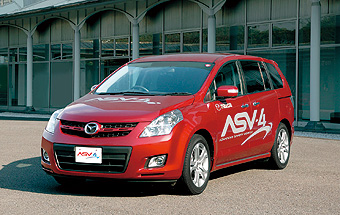NEWS RELEASES
Products and Technology
Mazda to Begin Public Road Trials of the Mazda ASV-4 Advanced Safety Vehicle
|
HIROSHIMA, Japan—Mazda Motor Corporation will commence public road trials of its advanced safety vehicle, Mazda ASV-4, in the Hiroshima area on March 11, 2008. The trials are based on the Advanced Safety Vehicle (ASV) Promotion Plan that was introduced by Japan’s Ministry of Land, Infrastructure, and Transportation (MLIT) to promote the development, practical application and wider use of ASV technologies aimed at reducing the number of traffic accidents. During the ASV Project’s Phase Four trials, Mazda will forge ahead with development of a safe driving support system that employs vehicle-to-vehicle communications.
In collaboration with other ASV project members in the Hiroshima area*1, Mazda will collect and analyze data to promote development of a safe driving support system. The system deploys safety technologies which utilize vehicle-to-vehicle communications to alert drivers of oncoming vehicles at blind intersections or on twisting roads with limited visibility. By reducing driver oversight or error, the system aims to mitigate two vehicle collisions at blind intersections, rear-end collisions and accidents when a vehicle performs right turns. Mazda plans to begin testing the two vehicle blind collision avoidance system in fiscal year 2007. Road trials of the right-turn and rear-end collision avoidance systems are set to commence in fiscal 2008.
The ASV project has been promoting the spread of safe driving to reduce traffic accidents through advanced technologies for over fifteen years since its inception by the MLIT in 1991. Mazda’s test results from Phase One to Phase Three have already resulted in the successful development of various advanced safety technologies. These include: a rear vehicle monitoring system that detects vehicles approaching from behind at highway speeds; and Mazda’s Precrash Safety System, which uses milliwave radar to monitor for oncoming obstacles, then alerts the driver and automatically applies the brakes if necessary. The Mazda ASV-4, part of the project’s fourth phase (2006 to 2010), will participate in the effort to promote the spread of ASV technologies and develop and implement a telecommunications-based safe driving support system to help reduce traffic accidents.
In January 2008, Mazda began trials to validate a new Intelligent Transport System (ITS)*2 as part of a consortium of local government, academia and industry in the Hiroshima area. The ITS consists of safe driving support technologies that link sensors installed along roadways to vehicles (road-to-vehicle communications) in order to detect potentially dangerous situations that the driver cannot see. By conducting the ASV public road trials in the same area as the ITS experiments, Mazda intends to evaluate the compatibility of the road-to-vehicle and vehicle-to-vehicle communication systems.
Mazda is dedicated to leveraging these road trial results, and its own research and development initiatives, to establish ITS and ASV technologies that can assist in reducing the number of traffic accidents and decrease the environmental burden caused by road traffic. Going forward, Mazda will continue to develop and evolve safety technologies that are helping to promote a sustainable transport environment for the future.
ASV-4 logo:
|

